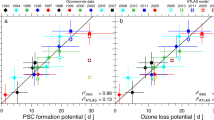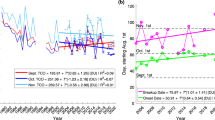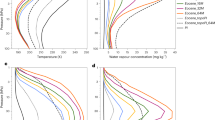Abstract
Large-scale chemical depletion of ozone due to anthropogenic emissions occurs over Antarctica as well as, to a lesser degree, the Arctic. Surface climate predictability in the Northern Hemisphere might be improved due to a previously proposed, albeit uncertain, link to springtime ozone depletion in the Arctic. Here we use observations and targeted chemistry–climate experiments from two models to isolate the surface impacts of ozone depletion from complex downward dynamical influences. We find that springtime stratospheric ozone depletion is consistently followed by surface temperature and precipitation anomalies with signs consistent with a positive Arctic Oscillation, namely, warm and dry conditions over southern Europe and Eurasia and moistening over northern Europe. Notably, we show that these anomalies, affecting large portions of the Northern Hemisphere, are driven substantially by the loss of stratospheric ozone. This is due to ozone depletion leading to a reduction in short-wave radiation absorption, when in turn causing persistent negative temperature anomalies in the lower stratosphere and a delayed break-up of the polar vortex. These results indicate that the inclusion of interactive ozone chemistry in atmospheric models can considerably improve the predictability of Northern Hemisphere surface climate on seasonal timescales.
This is a preview of subscription content, access via your institution
Access options
Access Nature and 54 other Nature Portfolio journals
Get Nature+, our best-value online-access subscription
$29.99 / 30 days
cancel any time
Subscribe to this journal
Receive 12 print issues and online access
$259.00 per year
only $21.58 per issue
Buy this article
- Purchase on Springer Link
- Instant access to full article PDF
Prices may be subject to local taxes which are calculated during checkout





Similar content being viewed by others
Data availability
The modelling data used in this study are available in the ETH Research Collection. Data for WACCM are available at https://www.research-collection.ethz.ch/handle/20.500.11850/52715565. Data for SOCOL-MPIOM are available at https://www.research-collection.ethz.ch/handle/20.500.11850/54603966. The MERRA2 reanalysis data can be downloaded from the Goddard Earth Sciences Data and Information Services Center (GES DIC) (https://disc.gsfc.nasa.gov/datasets?keywords=%22MERRA-2%22&page=1&source=Models%2FAnalyses%20MERRA-2).
Code availability
All codes and scripts used for the analysis in this study are available from the corresponding author upon reasonable request.
References
Solomon, S. Stratospheric ozone depletion: a review of concepts and history. Rev. Geophys. 37, 275–316 (1999).
Henriksen, T., Dahlback, A., Larsen, S. H. & Moan, J. Ultraviolet-radiation and skin cancer. Effect of an ozone layer depletion. Photochem. Photobiol. 51, 579–582 (1990).
Ballaré, C. L. et al. Impacts of solar ultraviolet-B radiation on terrestrial ecosystems of Tierra del Fuego (southern Argentina): an overview of recent progress. J. Photochem. Photobiol. B 62, 67–77 (2001).
Gillett, N. P. & Thompson, D. W. J. Simulation of recent Southern Hemisphere climate change. Science 302, 273–275 (2003).
Thompson, D. W. J. & Solomon, S. Interpretation of recent Southern Hemisphere climate change. Science 296, 895–899 (2002).
Bandoro, J., Solomon, S., Donohoe, A., Thompson, D. W. J. & Santer, B. D. Influences of the Antarctic ozone hole on Southern Hemispheric summer climate change. J. Clim. 27, 6245–6264 (2014).
Dennison, F., Mcdonald, A. & Morgenstern, O. The effect of ozone depletion on the Southern Annular Mode and stratosphere–troposphere coupling. J. Geophys. Res. Atmos. https://doi.org/10.1002/2014JD023009 (2015).
Thompson, D. et al. Signatures of the Antarctic ozone hole in Southern Hemisphere surface climate change. Nat. Geosci. 4, 741–749 (2011).
Gillett, Z. E. et al. Evaluating the relationship between interannual variations in the Antarctic ozone hole and Southern Hemisphere surface climate in chemistry–climate models. J. Clim. 32, 3131–3151 (2019).
Son, S.-W., Purich, A., Hendon, H. H., Kim, B.-M. & Polvani, L. M. Improved seasonal forecast using ozone hole variability? Geophys. Res. Lett. 40, 6231–6235 (2013).
Lawrence, Z. D. et al. The remarkably strong Arctic stratospheric polar vortex of winter 2020: links to record-breaking Arctic Oscillation and ozone loss. J. Geophys. Res. Atmos. 125, e2020JD033271 (2020).
Manney, G. L. et al. Record-low Arctic stratospheric ozone in 2020: MLS observations of chemical processes and comparisons with previous extreme winters. Geophys. Res. Lett. 47, e2020GL089063 (2020).
Ivy, D. J., Solomon, S., Calvo, N. & Thompson, D. W. J. Observed connections of Arctic stratospheric ozone extremes to Northern Hemisphere surface climate. Environ. Res. Lett. 12, 024004 (2017).
Calvo, N., Polvani, L. M. & Solomon, S. On the surface impact of Arctic stratospheric ozone extremes. Environ. Res. Lett. 10, 094003 (2015).
Stone, K. A., Solomon, S., Kinnison, D. E., Baggett, C. F. & Barnes, E. A. Prediction of Northern Hemisphere regional surface temperatures using stratospheric ozone information. J. Geophys. Res. Atmos. 124, 5922–5933 (2019).
Monge-Sanz, B. M. et al. A stratospheric prognostic ozone for seamless Earth system models: performance, impacts and future. Atmos. Chem. Phys. https://doi.org/10.5194/acp-22-4277-2022 (2022).
Ayarzagüena, B. & Serrano, E. Monthly characterization of the tropospheric circulation over the Euro-Atlantic area in relation with the timing of stratospheric final warmings. J. Clim. 22, 6313–6324 (2009).
Black, R. X. & McDaniel, B. A. The dynamics of Northern Hemisphere stratospheric final warming events. J. Atmos. Sci. 64, 2932–2946 (2007).
Domeisen, D. I. V. & Butler, A. H. Stratospheric drivers of extreme events at the Earth’s surface. Commun. Earth Environ. 1, 59 (2020).
Harari, O. et al. Influence of Arctic stratospheric ozone on surface climate in CCMI models. Atmos. Chem. Phys. 19, 9253–9268 (2019).
Rao, J. & Garfinkel, C. I. Arctic ozone loss in March 2020 and its seasonal prediction in CFSv2: a comparative study with the 1997 and 2011 cases. J. Geophys. Res. Atmos. 125, e2020JD033524 (2020).
Hersbach, H. et al. The ERA5 global reanalysis. Q. J. R. Meteorol. Soc. 146, 1999–2049 (2020).
Eyring, V. et al. Long-term ozone changes and associated climate impacts in CMIP5 simulations. J. Geophys. Res. Atmos. 118, 5029–5060 (2013).
Cionni, I. et al. Ozone database in support of CMIP5 simulations: results and corresponding radiative forcing. Atmos. Chem. Phys. 11, 11267–11292 (2011).
McCormack, J. P., Nathan, T. R. & Cordero, E. C. The effect of zonally asymmetric ozone heating on the Northern Hemisphere winter polar stratosphere. Geophys. Res. Lett. https://doi.org/10.1029/2010GL045937 (2011).
Zhang, J. et al. The Influence of zonally asymmetric stratospheric ozone changes on the Arctic polar vortex shift. J. Clim. 33, 4641–4658 (2020).
Haase, S. & Matthes, K. The importance of interactive chemistry for stratosphere–troposphere coupling. Atmos. Chem. Phys. 19, 3417–3432 (2019).
Gelaro, R. et al. The mModern-Era Retrospective Analysis for Research and Applications, version 2 (MERRA-2). J. Clim. 30, 5419–5454 (2017).
Baldwin, M. P. & Dunkerton, T. J. Stratospheric harbingers of anomalous weather regimes. Science 294, 581–584 (2001).
Domeisen, D. I. Estimating the frequency of sudden stratospheric warming events from surface observations of the North Atlantic Oscillation. J. Geophys. Res. Atmos. 124, 3180–3194 (2019).
Marsh, D. R. et al. Climate change from 1850 to 2005 simulated in CESM1(WACCM). J. Clim. 26, 7372–7391 (2013).
Muthers, S. et al. The coupled atmosphere–chemistry–ocean model SOCOL-MPIOM. Geosci. Model Dev. 7, 2157–2179 (2014).
Oehrlein, J., Chiodo, G. & Polvani, L. M. The effect of interactive ozone chemistry on weak and strong stratospheric polar vortex events. Atmos. Chem. Phys. 20, 10531–10544 (2020).
Solomon, S., Garcia, R., Rowland, F. & Wuebbles, D. On the depletion of Antarctic ozone. Nature 321, 755–758 (1986).
Kuroda, Y. & Kodera, K. Variability of the polar-night jet in the Northern and Southern Hemispheres. J. Geophys. Res. Atmos. 106, 20703–20713 (2001).
Kuroda, Y. & Kodera, K. Role of the Polar-night Jet Oscillation on the formation of the Arctic Oscillation in the Northern Hemisphere winter. J. Geophys. Res. Atmos. (2004). https://doi.org/10.1029/2003JD004123 (2004).
Runde, T., Dameris, M., Garny, H. & Kinnison, D. E. Classification of stratospheric extreme events according to their downward propagation to the troposphere. Geophys. Res. Lett. 43, 6665–6672 (2016).
Charney, J. G. & Drazin, P. G. Propagation of planetary-scale disturbances from the lower into the upper atmosphere. J. Geophys. Res. 66, 83–109 (1961).
Lin, P. et al. Dependence of model-simulated response to ozone depletion on stratospheric polar vortex climatology. Geophys. Res. Lett. 44, 6391–6398 (2017).
Butler, A. et al. in Sub-seasonal to Seasonal Prediction (eds Robertson, A. W. & Vitart, F.) 223–241 (Elsevier, 2019); https://doi.org/10.1016/B978-0-12-811714-9.00011-5
Nie, Y. et al. Stratospheric initial conditions provide seasonal predictability of the North Atlantic and Arctic Oscillations. Environ. Res. Lett. 14, 034006 (2019).
Domeisen, D. I. V. et al. The role of the stratosphere in subseasonal to seasonal prediction: 2. Predictability arising from stratosphere–troposphere coupling. J. Geophys. Res. Atmos. 125, e2019JD030923 (2020).
Butler, A. H., Perez, A. C., Domeisen, D. I. V., Simpson, I. R. & Sjoberg, J. Predictability of Northern Hemisphere final stratospheric warmings and their surface impacts. Geophys. Res. Lett. 43, 23 (2019).
Beerli, R., Wernli, H. & Grams, C. M. Does the lower stratosphere provide predictability for month-ahead wind electricity generation in Europe? Q. J. R. Meteorol. Soc. 143, 3025–3036 (2017).
Charlton-Perez, A. J., Aldridge, R. W., Grams, C. M. & Lee, R. Winter pressures on the UK health system dominated by the Greenland Blocking weather regime. Weather Clim. Extrem. 25, 100218 (2019).
Butler, A. H. et al. The Climate-System Historical Forecast Project: do stratosphere-resolving models make better seasonal climate predictions in boreal winter? Q. J. R. Meteorol. Soc. 142, 1413–1427 (2016).
Kolstad, E. W., Wulff, C. O., Domeisen, D. I. V. & Woollings, T. Tracing North Atlantic Oscillation forecast errors to stratospheric origins. J. Clim. 33, 9145–9157 (2020).
Domeisen, D. I. et al. The role of the stratosphere in subseasonal to seasonal prediction: 1. Predictability of the stratosphere. J. Geophys. Res. Atmos. 125, e2019JD030920 (2020).
Bednarz, E. M. et al. Future Arctic ozone recovery: the importance of chemistry and dynamics. Atmos. Chem. Phys. 16, 12159–12176 (2016).
Danabasoglu, G. et al. The CCSM4 ocean component. J. Clim. 25, 1361–1389 (2012).
Holland, M. M., Bailey, D. A., Briegleb, B. P., Light, B. & Hunke, E. Improved sea ice shortwave radiation physics in CCSM4: the impact of melt ponds and aerosols on Arctic sea ice. J. Clim. 25, 1413–1430 (2012).
Rieder, H. E., Chiodo, G., Fritzer, J., Wienerroither, C. & Polvani, L. M. Is interactive ozone chemistry important to represent polar cap stratospheric temperature variability in Earth-system models? Environ. Res. Lett. 14, 044026 (2019).
Kinnison, D. E. et al. Sensitivity of chemical tracers to meteorological parameters in the MOZART-3 chemical transport model. J. Geophys. Res. Atmos. https://doi.org/10.1029/2006JD007879 (2007).
Smith, K. L., Neely, R. R., Marsh, D. R. & Polvani, L. M. The Specified Chemistry Whole Atmosphere Community Climate Model (SC-WACCM). J. Adv. Model. Earth Syst. 6, 883–901 (2014).
Egorova, T., Rozanov, E., Zubov, V. & Karol, I. Model for investigating ozone trends (MEZON). Izvestiya Atmos. Ocean Phys. 39, 277–292 (2003).
Stenke, A. et al. The SOCOL version 3.0 chemistry–climate model: description, evaluation, and implications from an advanced transport algorithm. Geosci. Model Dev. 6, 1407–1427 (2013).
Brönnimann, S., Annis, J. L., Vogler, C. & Jones, P. D. Reconstructing the quasi-biennial oscillation back to the early 1900s. Geophys. Res. Lett. https://doi.org/10.1029/2007GL031354 (2007).
Meinshausen, M. et al. The RCP greenhouse gas concentrations and their extensions from 1765 to 2300. Climatic Change 109, 213–241 (2011).
Waugh, D. W. et al. Effect of zonal asymmetries in stratospheric ozone on simulated Southern Hemisphere climate trends. Geophys. Res. Lett. https://doi.org/10.1029/2009GL040419 (2009).
Baldwin, M. P. & Thompson, D. W. A critical comparison of stratosphere–troposphere coupling indices. Q. J. R. Meteorol. Soc. 135, 1661–1672 (2009).
Andrews, D. G., Holton, J. R. & Leovy, C. B. Middle Atmosphere Dynamics (Academic Press, 1987).
Calvo, N., Garcia, R. R. & Kinnison, D. E. Revisiting Southern Hemisphere polar stratospheric temperature trends in WACCM: the role of dynamical forcing. Geophys. Res. Lett. 44, 3402–3410 (2017).
Garcia, R. R., Kinnison, D. E. & Marsh, D. R. “World avoided” simulations with the Whole Atmosphere Community Climate Model. J. Geophys. Res. Atmos. https://doi.org/10.1029/2012JD018430 (2012).
Butler, A. H. & Gerber, E. P. Optimizing the definition of a sudden stratospheric warming. J. Clim. 31, 2337–2344 (2018).
Friedel, M. & Chiodo, G. Model results for “Robust effect of springtime Arctic ozone depletion on surface climate”. ETH Zürich https://doi.org/10.3929/ethz-b-000527155 (2022).
Friedel, M. & Chiodo, G. Model results for “Robust effect of springtime Arctic ozone depletion on surface climate”, part 2. Data for SOCOL-MPIOM. ETH Zürich https://doi.org/10.3929/ethz-b-000546039 (2022).
Acknowledgements
We are grateful for the assistance from U. Beyerle in data management and thank S. Muthers for support in the chemistry–climate modelling with SOCOL-MPIOM. Support from the Swiss National Science Foundation through Ambizione Grant PZ00P2_180043 for M.F. and G.C and projects PP00P2_170523 and PP00P2_198896 to D.D. is gratefully acknowledged.
Author information
Authors and Affiliations
Contributions
G.C. conceived the modelling experiments. G.C., M.F., A.S. and J.A. conducted the modelling experiments. M.F. and G.C. processed the data. M.F., G.C., T.P., D.D. and S.F. analysed and interpreted the results. M.F. wrote the paper with input from all authors.
Corresponding author
Ethics declarations
Competing interests
The authors declare no competing interests.
Peer review
Peer review information
Nature Geoscience thanks Robyn Schofield and the other, anonymous, reviewer(s) for their contribution to the peer review of this work. Primary Handling Editor: James Super, in collaboration with the Nature Geoscience team.
Additional information
Publisher’s note Springer Nature remains neutral with regard to jurisdictional claims in published maps and institutional affiliations.
Extended data
Extended Data Fig. 1 Surface climate following springtime Arctic ozone depletion in SOCOL-MPIOM.
Composites of sea level pressure (a, d, g), surface temperature (b, e, h) and precipitation (c, f, i) in SOCOL-MPIOM INT-3D (top row), CLIM-3D (middle row) and CLIM-2D (bottom row) after ozone minima in the 25% of winters with most extreme ozone loss (average over the 30 days after the ozone minimum date). Stippling shows significance on a 4.6% level following a bootstrapping test. Further discussion on this Figure is found in the supplementary information (section S1).
Extended Data Fig. 2 The Arctic Oscillation (AO) index following winters with extreme ozone.
The box plot shows the distribution of the mean AO index (20 - 90° N) at 1000 hPa in the 30 days following the ozone minimum for WACCM and SOCOL-MPIOM (INT-3D (red), CLIM-3D (blue) and CLIM-2D (grey)) and MERRA2 (left box). Triangles and numbers indicate the mean AO index in the 30 days after the ozone minima averaged over the 25% most extreme winters. The upper and lower edges of the boxes show the upper and lower quartile, the whiskers represent the maximum and minimum values of the respective distribution. Grey lines show averages over model simulations. Further discussion on this Figure is found in the supplementary information (sections S1, S2).
Extended Data Fig. 3 Influence of ozone depletion on stratosphere-troposphere coupling in SOCOL-MPIOM.
Composites of Northern Annular Mode (NAM) indices (20 - 90° N) around the ozone minima in SOCOL-MPIOM INT-3D (a), CLIM-3D (b) and CLIM-2D (c). Day zero indicates the ozone minimum date. Stippling shows significance on a 4.6% level following a bootstrapping test. Further discussion on this Figure is found in the supplementary information (section S1).
Extended Data Fig. 4 Impact of ozone feedbacks on shortwave and dynamical heating in WACCM and SOCOL-MPIOM.
Differences of polar cap (60-90° N) temperature (a-d), ozone (e-h), shortwave heating (i-l) and dynamical heating (m-p) anomalies between INT-3D and CLIM-3D as well as between INT-3D and CLIM-2D around the ozone minima in WACCM (first and second column) and SOCOL-MPIOM (third and fourth column). Day zero indicates the ozone minimum date. Contour lines in the temperature plot show temperature anomalies around the ozone minima in CLIM with a contour interval of 1.5 K. Stippling shows significance on a 4.6% level following a bootstrapping test. Further discussion on this Figure is found in the supplementary information (section S1).
Extended Data Fig. 5 Influence of ozone feedbacks on surface climate in WACCM.
Difference in mean SLP (a, d), surface temperature (b, e) and precipitation (c, f) anomalies in INT-3D minus CLIM-3D (upper row) and INT-3D minus CLIM-2D (bottom row) for the 25% of years with the lowest springtime ozone concentrations in WACCM (average over the 30 days after the ozone minimum date). Stippling shows significance on a 4.6% level following a bootstrapping test. Further discussion on this Figure is found in the supplementary information (section S2).
Extended Data Fig. 6 Influence of ozone feedbacks on surface climate in SOCOL.
Difference in mean SLP (a, d), surface temperature (b, e) and precipitation (c, f) anomalies in INT-3D - CLIM-3D (upper row) and INT-3D - CLIM-2D (bottom row) for the 25% of years with the lowest spring ozone concentrations in SOCOL-MPIOM (average over the 30 days after the ozone minimum date). Stippling shows significance on a 4.6% level following a bootstrapping test. Further discussion on this Figure is found in the supplementary information (section S2).
Supplementary information
Supplementary Information
Supplementary Figs. 1–10, Tables 1 and 2 and discussion.
Extended data
Rights and permissions
About this article
Cite this article
Friedel, M., Chiodo, G., Stenke, A. et al. Springtime arctic ozone depletion forces northern hemisphere climate anomalies. Nat. Geosci. 15, 541–547 (2022). https://doi.org/10.1038/s41561-022-00974-7
Received:
Accepted:
Published:
Issue Date:
DOI: https://doi.org/10.1038/s41561-022-00974-7
This article is cited by
-
Changes in tropospheric air quality related to the protection of stratospheric ozone in a changing climate
Photochemical & Photobiological Sciences (2023)
-
Interactive effects of changes in UV radiation and climate on terrestrial ecosystems, biogeochemical cycles, and feedbacks to the climate system
Photochemical & Photobiological Sciences (2023)
-
Stratospheric ozone, UV radiation, and climate interactions
Photochemical & Photobiological Sciences (2023)
-
Role of Stratospheric Processes in Climate Change: Advances and Challenges
Advances in Atmospheric Sciences (2023)



